Posted by: Northwest Eye in LASIK on November 9, 2025
Overview
We understand that considering LASIK surgery can bring up many questions and emotions. The minimum age to undergo this procedure is 18 years old. This requirement is in place to ensure that individuals have reached ocular maturity and that their eyesight has stabilized.
It’s common to feel uncertain about age-related factors when it comes to eye health. While there isn’t a strict upper age limit for LASIK, those over 40 may need additional assessments to determine their eligibility. This is due to the natural changes in eyesight that can occur with age.
We are here to help you through this process and provide the support you need. If you have any concerns or questions, don’t hesitate to reach out. Your journey to clearer vision is important to us.
Introduction
Understanding the age requirements for LASIK surgery is essential for anyone considering this important step in their vision correction journey. We understand that making decisions about your eyesight can feel overwhelming. While the FDA mandates that candidates must be at least 18 years old to ensure ocular maturity, there are many factors that influence eligibility beyond just age.
It’s common to feel uncertain about what makes someone a good candidate for LASIK. Factors like:
- Prescription stability
- Comprehensive eye health assessments
- Lifestyle considerations
all play a significant role in determining if LASIK is right for you. We want you to feel informed and supported as you navigate these complexities.
With so much at stake, how can you make the best decision for your vision? Remember, you’re not alone in this process. Many individuals have faced similar questions and concerns. We are here to help you through this journey, ensuring you have the information you need to make confident choices about your eye health.
Northwest Eye: Leading Provider of LASIK Surgery in Minnesota
For over 50 years, Northwest Eye has been a cornerstone of eye care in Minnesota, particularly in vision correction surgery. We understand that considering eye surgery can be a significant decision, and we’re here to support you every step of the way. Our clinic employs cutting-edge technology and a patient-focused approach, successfully performing thousands of eye surgeries with an impressive 96% patient satisfaction rate.
We know how important personalized care is to you. That’s why we incorporate innovative techniques like the Light Adjustable Lens, which allows for tailored vision correction. It’s common to feel a mix of excitement and apprehension when thinking about surgery, but rest assured, our commitment to excellence means you’re in good hands.
With a strong emphasis on the latest advancements in vision correction technology, Northwest Eye stands out as a top choice for those seeking compassionate and effective eye care solutions. We are here to help you through this process, ensuring you feel informed and confident in your decisions.
FDA Age Requirements for LASIK Surgery: What You Need to Know
We understand that considering eye surgery can bring up many questions and concerns. The FDA requires that applicants for eye surgery understand how old do you have to be to get lasik, which is at least 18 years old. This age requirement is essential because it ensures that individuals have reached ocular maturity, which answers the question of how old do you have to be to get lasik, meaning their eyesight has stabilized. While there’s no strict upper age limit for the procedure, it’s common for individuals over 40 to need further assessments to determine their eligibility. This is due to potential age-related changes in eyesight, such as presbyopia.
Dr. Kashish Gupta emphasizes the importance of thorough assessments for those in their 40s and older. These evaluations help to understand your specific sight requirements better. It’s crucial for applicants to engage in comprehensive discussions with their eye care professionals regarding how old do you have to be to get lasik. This way, you can fully grasp how your age and overall eye health may impact how old do you have to be to get lasik.
Research indicates that most people aged 25 to 30 have consistent prescriptions, with 90% achieving 20/20 vision or better. This makes this age group particularly advantageous for vision correction surgery. Additionally, applicants should demonstrate prescription stability for at least 12-24 months before considering eye surgery.
Understanding these age-related factors is vital for making informed choices about eye surgery. Remember, we are here to help you through this process and ensure you feel supported every step of the way.
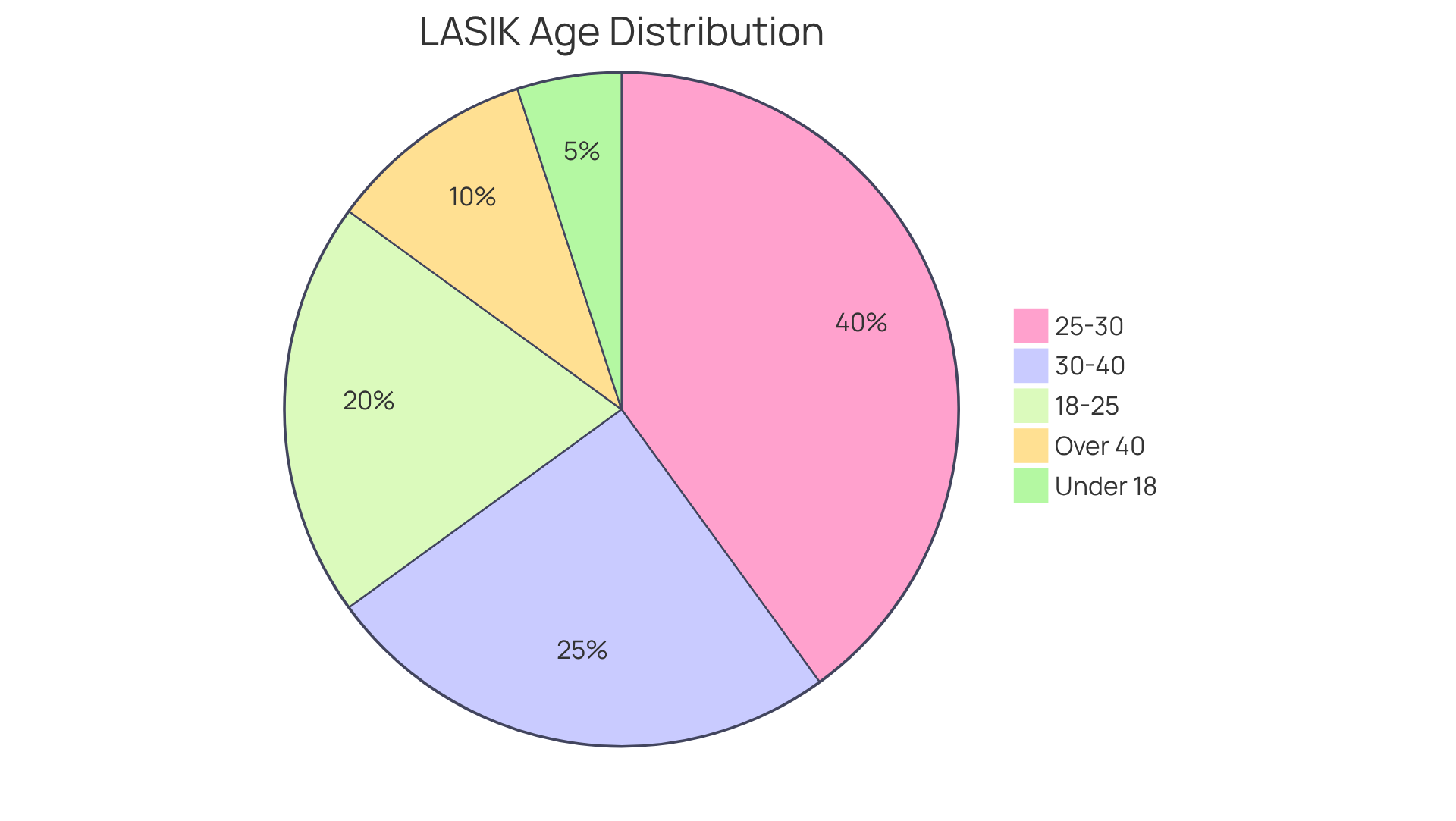
Prescription Stability: A Key Factor for LASIK Eligibility
We understand that considering LASIK surgery can be a significant decision, and it’s essential to feel confident about the process. For a successful LASIK procedure, individuals should have a stable vision prescription for at least two years prior to surgery. This means there should be no significant changes in your eyeglass or contact lens prescription during this time. A stable prescription indicates that your eyes have matured and are less likely to change after the surgery, which is crucial for achieving the desired visual outcomes.
It’s common to feel uncertain about whether you meet this requirement, but discussing your prescription history with your eye care provider can provide clarity and reassurance. Studies show that patients who adhere to this guideline experience higher satisfaction rates and better long-term results. Many patients, like Suzanne S., have shared their success stories, transitioning from needing -5.00 prescription contact lenses to enjoying life without glasses or contacts at all. Imagine the freedom of seeing clearly!
However, it’s important to recognize that specific conditions, such as keratoconus, may prevent some individuals from undergoing the procedure. This highlights the necessity for a comprehensive assessment of your eye health. Remember, we are here to help you through this process and ensure you have all the information you need to make the best decision for your vision.
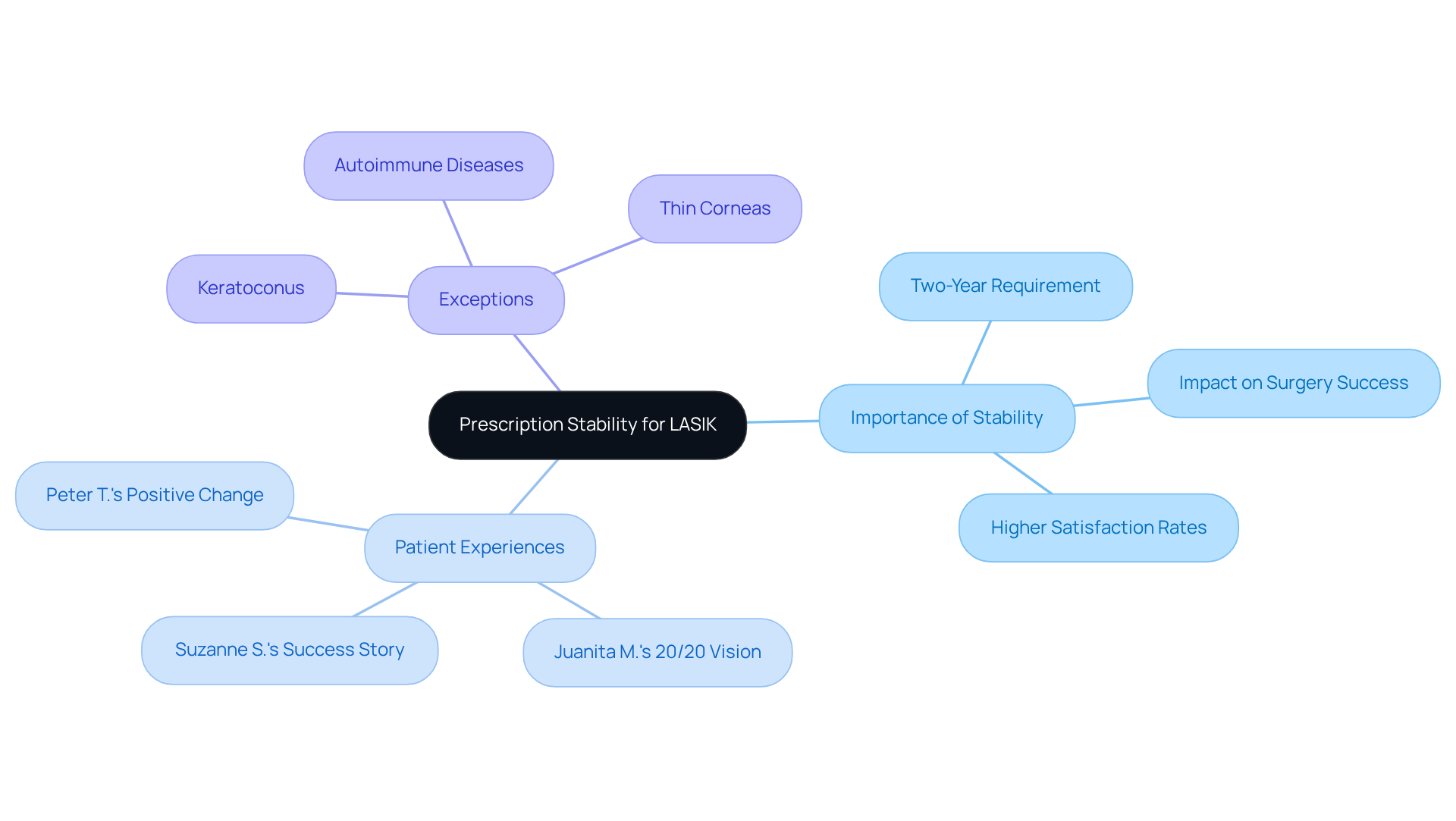
Comprehensive Eye Health Assessment: Ensuring LASIK Suitability
If you’re considering laser eye surgery, a comprehensive eye health evaluation is an essential first step. We understand that this process can feel overwhelming, but rest assured, this evaluation includes several important tests designed to ensure your safety and comfort. These tests measure corneal thickness, assess overall eye health, and screen for conditions like dry eye syndrome and corneal irregularities, including Keratoconus.
Keratoconus is a progressive condition where the cornea thins and develops an abnormal curvature. This can lead to symptoms such as blurry or double vision and light sensitivity. Recognizing these factors is vital to ensure that the procedure is both safe and effective for you. If Keratoconus is detected, treatment options like specially fitted contact lenses or Corneal Collagen Cross-Linking may be recommended.
The assessment process not only determines your suitability for surgery but also allows your surgeon to tailor the procedure to your unique needs. For instance, if you have dry eye syndrome, additional treatments might be suggested before your surgery to enhance your chances of a successful outcome.
Moreover, advanced technologies, such as wavefront analysis, are often used during these evaluations. This technology provides a detailed map of your eye’s refractive errors, allowing surgeons to customize the surgery more effectively, ultimately leading to better visual results.
In summary, a thorough eye health evaluation is a crucial step in your journey. It ensures that you receive personalized care, enhancing your opportunities for ideal correction. Remember, we are here to help you through this process, and your comfort and well-being are our top priorities.
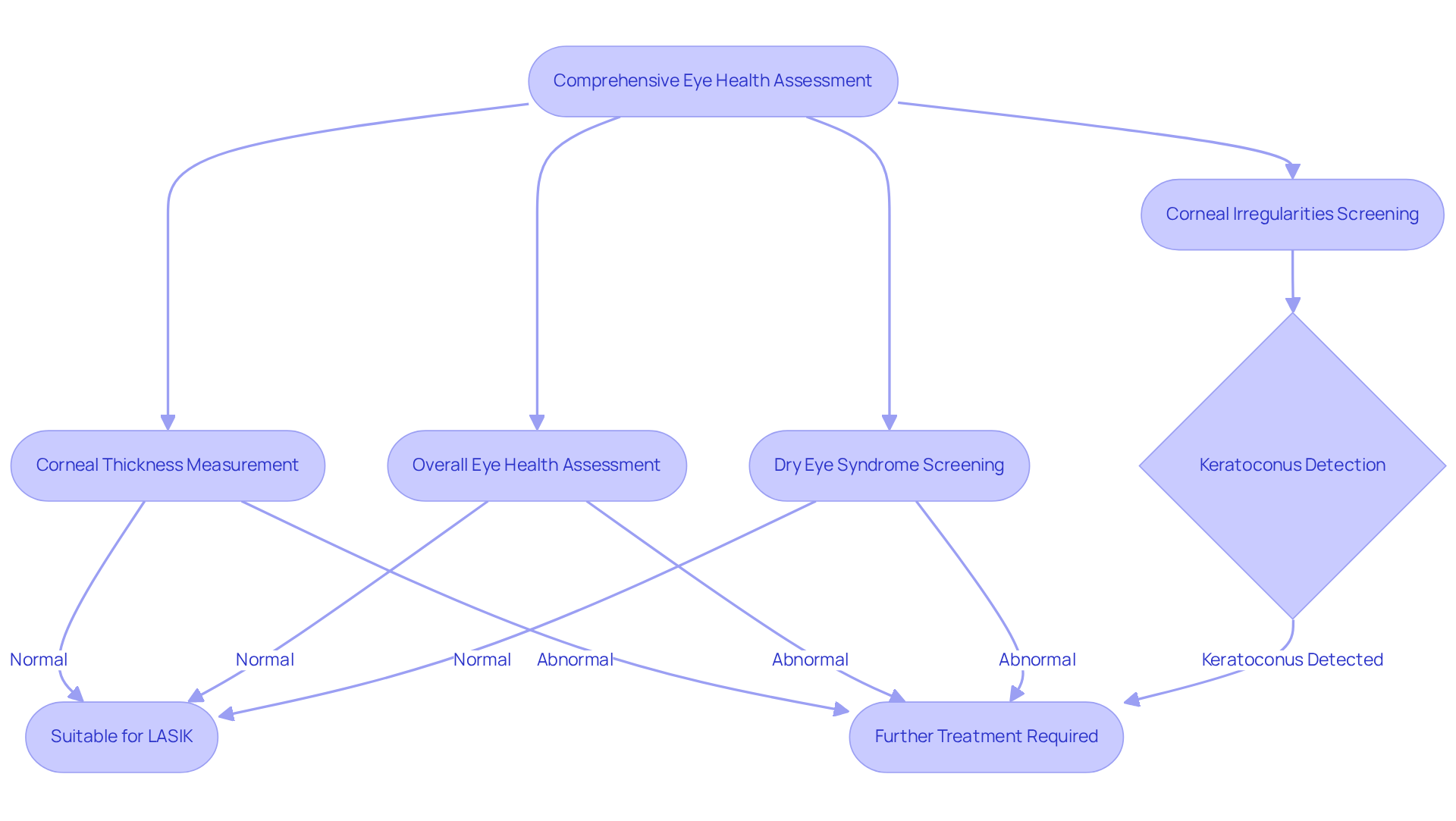
Lifestyle Considerations: Impact on LASIK Candidacy
Lifestyle considerations play a crucial role in determining LASIK candidacy and recovery. We understand that engaging in contact sports or having jobs that increase the risk of eye injury can be concerning. In such cases, alternative vision correction methods might be necessary. Additionally, habits like smoking and excessive alcohol consumption can significantly hinder healing and affect surgical outcomes.
Research indicates that smoking can obstruct the healing process and increase the risk of complications, such as dryness and infections. It’s alarming to note that conditions caused by smoking can even lead to complete blindness. Smoking also makes blood cells stickier in the eyes, raising the chances of retinal vascular occlusions. To optimize healing potential, patients are advised to stop smoking at least eight weeks before surgery. Dr. John Goosey emphasizes that smoking can prolong recovery from eye surgery by stressing the heart and lowering blood oxygen levels.
Similarly, alcohol consumption can disrupt inflammatory responses and reduce the effectiveness of post-operative medications, complicating recovery further. Alcohol weakens the immune system, making individuals more vulnerable to infections, which is particularly concerning after surgery.
We encourage candidates to have open conversations with their eye care specialists about their lifestyle choices. Understanding how these factors can influence your vision correction journey is essential. Remember, we are here to help you through this process.
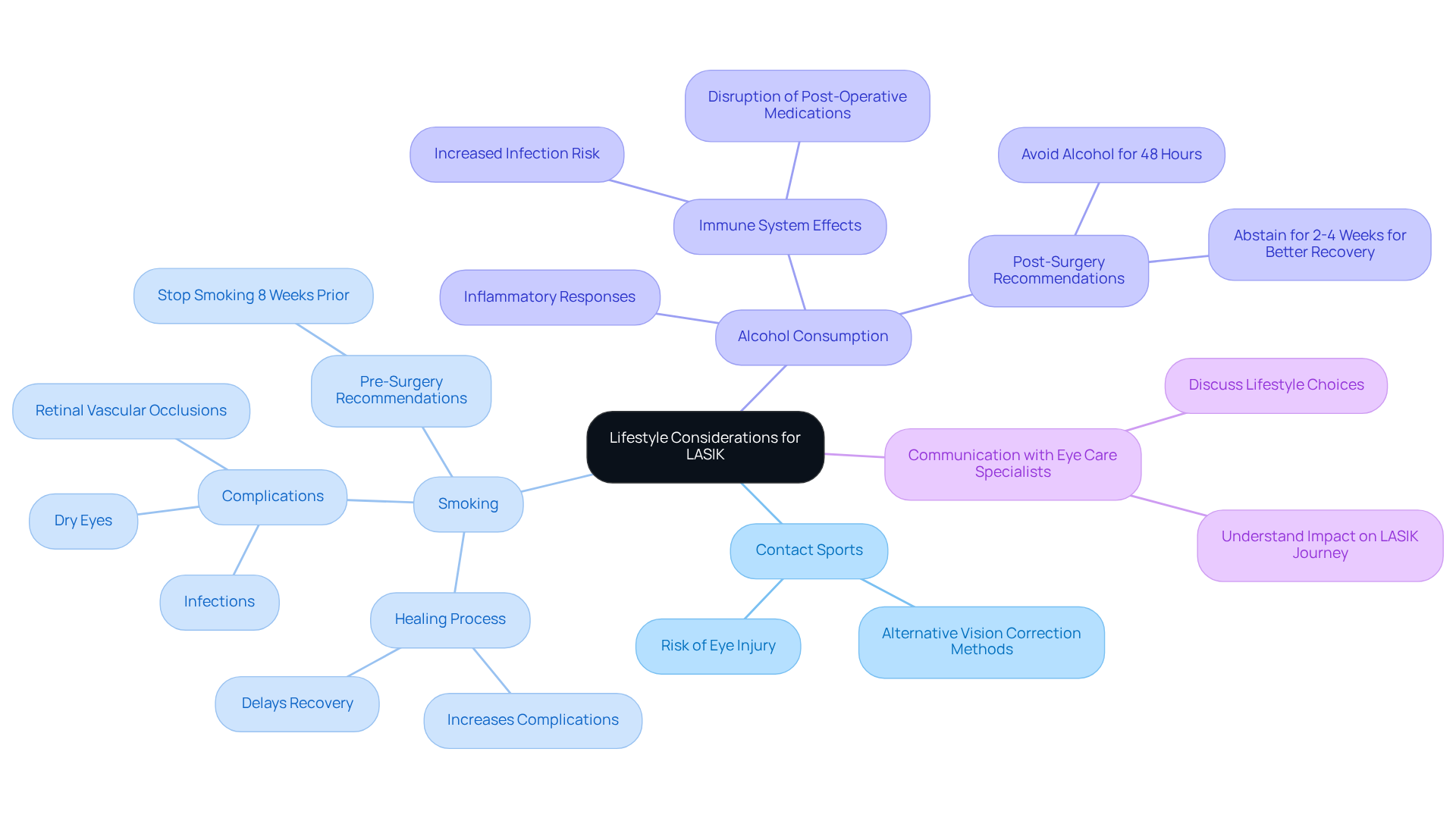
Alternative Vision Correction Options: Beyond LASIK
If you’re feeling uncertain about whether laser eye surgery is right for you, rest assured that there are several alternative correction options available. One notable choice is Photorefractive Keratectomy (PRK). This procedure is similar to LASIK but doesn’t involve creating a corneal flap, making it a great option for those with thinner corneas. PRK reshapes the cornea’s surface without the risks associated with flap complications. Research shows that about 90-95% of PRK patients achieve at least 20/40 vision without glasses or contacts, which is quite encouraging. However, it’s important to note that PRK typically requires about a week off work, and full visual recovery can take anywhere from 1 to 3 months. You might experience blurred vision for several days to weeks during recovery, so it’s essential to set realistic expectations.
Another option to consider is implantable contact lenses (ICL). This is particularly ideal for those with high prescriptions or thin corneas that may not be suitable for laser procedures. ICL surgery involves placing a biocompatible lens behind the iris, allowing for significant vision correction while keeping the cornea intact. Many patients report high satisfaction rates, with around 95% expressing happiness with their results. However, it’s crucial to be aware of potential risks associated with ICL surgery, such as increased eye pressure or infection.
Refractive lens exchange (RLE) is also worth considering, especially for individuals dealing with presbyopia or those who aren’t candidates for LASIK or PRK. This procedure replaces the eye’s natural lens with an artificial intraocular lens (IOL), effectively addressing age-related vision issues.
We understand that navigating these options can feel overwhelming, which is why consulting with an eye care professional is so important. They can help you determine the best choice based on your unique needs, lifestyle, and eye health. Each procedure comes with its own set of benefits and risks, and a thorough evaluation will ensure you make the most suitable choice for optimal vision correction. As Dr. CT Pillai, a globally recognized ophthalmologist, wisely states, “Your prescription, corneal thickness, and lifestyle will help determine the best procedure for you.” We are here to help you through this process.
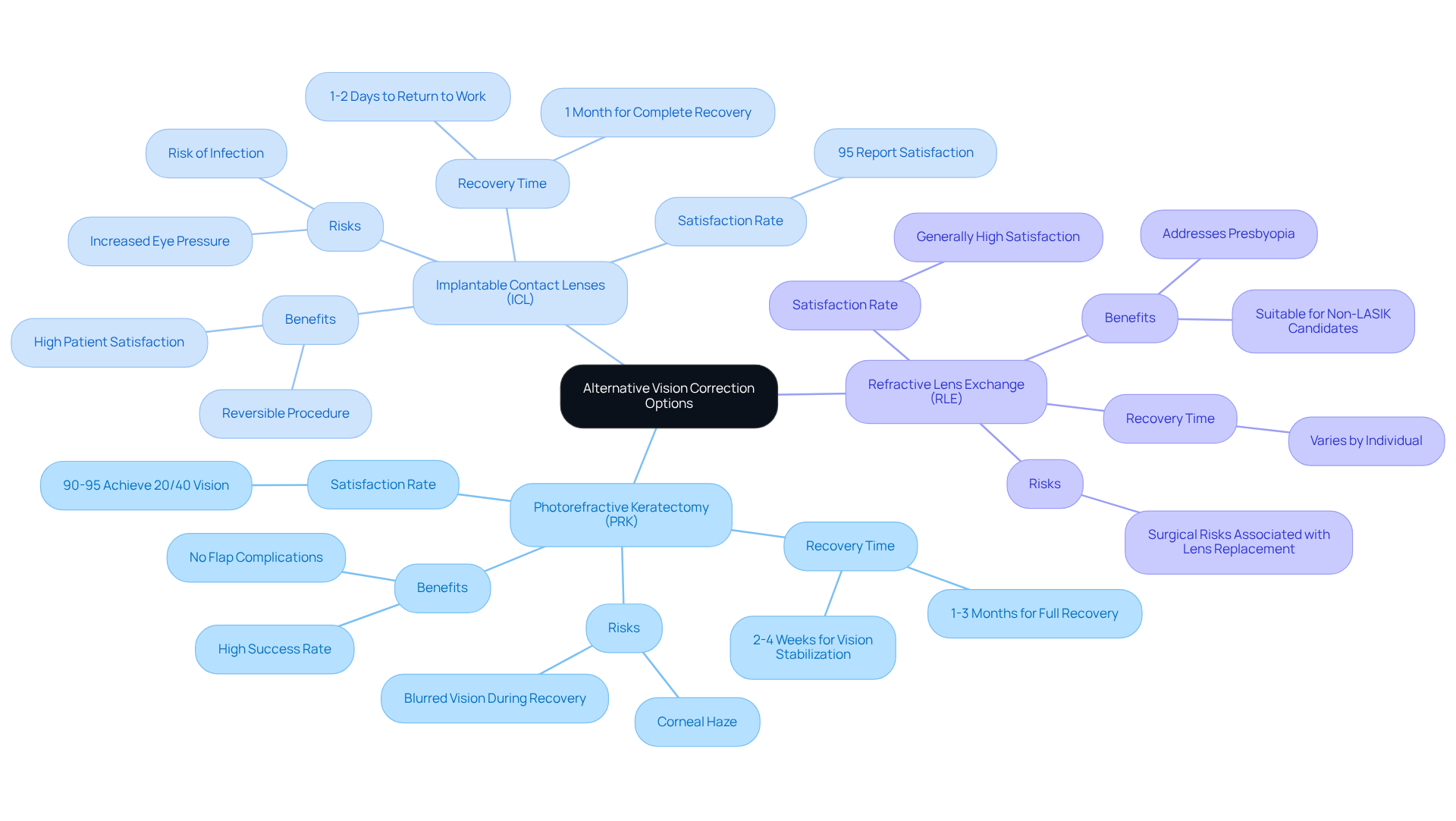
Critical Evaluation Factors: Beyond Just Age for LASIK
While age is an important factor in determining how old do you have to be to get lasik, it’s not the only consideration. We understand that many of you may have concerns about your overall eye health, prescription stability, corneal thickness, and any underlying eye conditions. For instance, having sufficient corneal thickness is crucial for the safety and effectiveness of the procedure. Most patients typically have corneas measuring between 540-550 microns. Although advanced laser technologies can accommodate thinner corneas, this requires careful assessment by a qualified specialist.
It’s common to feel uncertain, especially when statistics show that a significant number of individuals seeking this procedure may have underlying eye issues that could affect their eligibility. Conditions like cataracts, Fuchs’ dystrophy, and uncorrected refractive errors can lead to symptoms such as halos and glare while driving at night. These factors are vital to consider during the evaluation process. A comprehensive evaluation is essential to identify these issues, as certain conditions can complicate healing and overall outcomes. Additionally, candidates should have a stable vision prescription for at least one year before undergoing the procedure, as fluctuating vision may suggest it’s best to wait until things stabilize, which leads to the question of how old do you have to be to get lasik.
The criteria for eye surgery evaluations have evolved over time. With recent advancements in technology, we can now conduct more precise assessments. Candidates can expect a thorough consultation that includes measuring corneal thickness and reviewing their complete medical history. This ensures that all relevant factors are considered, leading to informed decisions about moving forward with the procedure. It’s reassuring to know that only 10-15% of patients are excluded during vision correction consultations, highlighting the thoroughness of the assessment process.
Ultimately, a personalized approach is vital. As Dr. Robert Dinga emphasizes, “Your distinctive eye profile and the technology applied will decide your appropriateness for the procedure.” This underscores the importance of working with a knowledgeable eye care professional who can guide you through the assessment process and help you understand your options. Furthermore, it’s essential to be aware of potential side effects of the procedure, such as dry eyes, glare, and halos, to set realistic expectations. Following pre- and post-surgery guidelines is crucial for achieving optimal outcomes.
We are here to help you through this process, ensuring you feel supported every step of the way.

Refractive Stability and Ocular Maturation: Key to LASIK Success
We understand that considering eye surgery can be a significant decision, and it’s natural to have questions and concerns. Refractive stability and ocular maturation play crucial roles in ensuring a successful outcome. Typically, ocular maturation occurs in the mid-20s, which leads to the question of how old do you have to be to get lasik, as this is when eye prescriptions tend to stabilize.
It’s important for candidates to have a stable prescription for at least one year before surgery. This stability minimizes the risk of complications and helps ensure the best possible results. When your prescription is stable, it allows your surgeon to accurately assess your refractive error and tailor the procedure to your unique needs. This personalized approach ultimately leads to better visual outcomes, giving you the clarity and confidence you deserve.
We are here to help you through this process, and we want you to feel reassured every step of the way.

Consultation Process: Your First Step Towards LASIK
The eye surgery consultation process is a vital first step toward achieving clearer vision. We understand that this can be a significant moment for you, and during this appointment, you’ll undergo a thorough eye examination. This evaluation looks at corneal thickness, overall eye health, and the stability of your prescription, all of which are essential for determining your candidacy for the procedure.
Your eye care provider will take the time to explain the LASIK procedure in detail. They’ll discuss potential risks and expected outcomes, ensuring you feel well-informed and supported. This session is also a great opportunity for you to ask questions and express any concerns you may have. Remember, it’s common to feel a bit anxious about these things, and we’re here to help you through this process.
To make the most of your consultation experience, it’s helpful to prepare by gathering your medical history and reflecting on your personal vision goals. Understanding these aspects can lead to a more productive dialogue with your eye care provider. On average, the eye surgery consultation lasts about 1.5 to 2 hours, giving you ample time for comprehensive assessments and discussions.
Many patients emphasize the importance of clear communication and establishing realistic expectations during their consultations. These elements are crucial for a successful eye surgery journey. We want you to feel confident and reassured as you take this important step toward better vision.
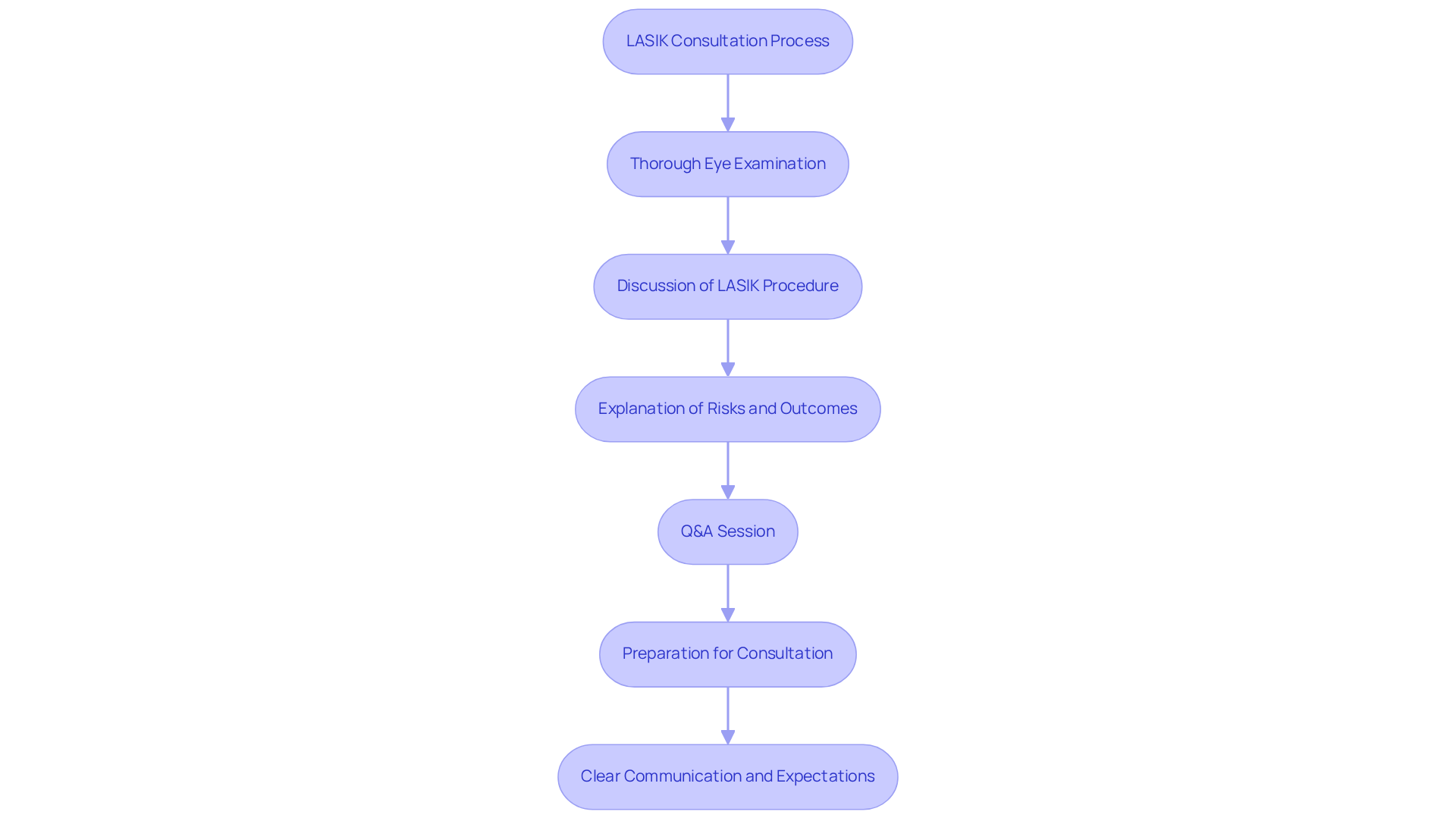
Long-term Considerations: What LASIK Candidates Should Know
If you’re considering laser eye surgery, it’s completely normal to have concerns about the long-term effects on your vision. Many studies show that over 90% of individuals who undergo this procedure achieve 20/20 vision or better. However, it’s important to understand that as we age, our eyesight can change due to natural processes like presbyopia, which affects nearly everyone.
We understand that regular follow-up appointments with your eye care provider are essential. These visits help monitor your vision stability and address any emerging concerns. For instance, research indicates that 94.9% of patients who had laser eye surgery no longer need distance correction five years later. Yet, it’s crucial to remember that this surgery doesn’t prevent future changes in your eyesight. Setting realistic expectations is key to ensuring your ongoing eye health.
It’s common to feel a bit anxious about what the future holds. Eye specialists emphasize that while the procedure can significantly enhance your vision, it doesn’t eliminate the possibility of age-related issues. At Northwest Eye, we’re here to support you with innovative solutions like the Light Adjustable Lens, which can be particularly beneficial for LASIK candidates. This option allows for adjustable vision correction as your eyesight changes over time.
Therefore, maintaining routine check-ups is vital for the early detection and management of any potential issues. Remember, we are here to help you through this process, ensuring you feel supported every step of the way.

Conclusion
Understanding the age requirements and various factors involved in LASIK surgery is essential for anyone considering this life-changing procedure. We understand that this decision can feel overwhelming, and it’s important to know that the FDA mandates candidates must be at least 18 years old. This ensures that their eyes have reached maturity and their vision prescriptions have stabilized. However, age is just one piece of the puzzle. Comprehensive assessments of eye health, prescription stability, and lifestyle considerations are equally important in determining candidacy.
It’s common to feel uncertain about whether you meet the criteria. Throughout this article, we’ve highlighted the necessity of having a stable vision prescription for at least one to two years prior to surgery. Additionally, thorough eye health evaluations are crucial to identify any underlying conditions that may affect the outcome. Lifestyle factors, such as smoking and participation in contact sports, can significantly impact both candidacy and post-operative recovery. Remember, with alternatives like PRK and ICL available, you have options that may suit your unique needs better.
Ultimately, it’s crucial for potential candidates to engage in open discussions with their eye care professionals. We are here to help you through this complex process effectively. By prioritizing informed decision-making and comprehensive evaluations, you can confidently pursue your vision correction goals. Empowerment through knowledge will lead to a more successful LASIK experience, ensuring that you can enjoy the clarity and freedom of improved vision for years to come.
Frequently Asked Questions
What is Northwest Eye known for?
Northwest Eye is a leading provider of LASIK surgery in Minnesota, with over 50 years of experience in eye care and a focus on vision correction surgery.
What is the patient satisfaction rate at Northwest Eye?
Northwest Eye has an impressive patient satisfaction rate of 96% based on their successful performance of thousands of eye surgeries.
What innovative techniques does Northwest Eye use for vision correction?
Northwest Eye incorporates innovative techniques like the Light Adjustable Lens, which allows for personalized vision correction tailored to individual needs.
What is the FDA age requirement for LASIK surgery?
The FDA requires that applicants for LASIK surgery be at least 18 years old to ensure they have reached ocular maturity and their eyesight has stabilized.
Is there an upper age limit for LASIK surgery?
There is no strict upper age limit for LASIK surgery; however, individuals over 40 may need further assessments due to potential age-related changes in eyesight.
Why is prescription stability important for LASIK eligibility?
Individuals should have a stable vision prescription for at least two years prior to LASIK surgery, as this indicates that their eyes have matured and are less likely to change after the procedure.
What percentage of people aged 25 to 30 achieve 20/20 vision or better after LASIK?
Research indicates that 90% of individuals aged 25 to 30 achieve 20/20 vision or better after LASIK, making this age group particularly advantageous for the surgery.
What should applicants do if they have concerns about their eligibility for LASIK?
Applicants should engage in comprehensive discussions with their eye care professionals to understand how their age, overall eye health, and prescription stability may impact their eligibility for LASIK surgery.
Can certain eye conditions prevent someone from undergoing LASIK?
Yes, specific conditions such as keratoconus may prevent some individuals from undergoing LASIK surgery, highlighting the need for a comprehensive assessment of eye health.






